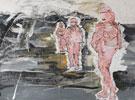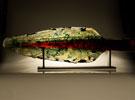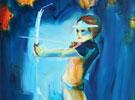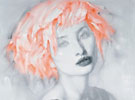Winding
Zhao Li
In 2009, two solo shows of Li Wei were held, which was a remarkable milestone for the young artist. Her solo show, Simplicity and Complexity, held in the Today Art Museum of Beijing, was an exhibition of a variety of her works, from those on paper to those on canvas, from those executed when she was a student to those executed after her graduation. The title of the solo show, Simplicity and Complexity, indicated her style of this period. She aspired to create a simple and solid form of art. Meanwhile, she wanted the form to be scalable and serve as the prototype of her artwork series.
Carbon paper was rarely known as a medium for art. However, Li Wei had been using it in her works for quite a period of time. She was the first to use it as an element of her artwork. Carbon paper was both the carrier of images and the converter of image structures consisting of dots. The works took advantage of image polymorphism and corresponded to reality in an implicit way.
The dots were the fundamental building blocks of her works. The technique was derived from modern printing technology. She manually simulated the effect of color printing and concentrated on reflection upon industrialization, mechanization, handwork and nature. The adoption of dots brought about a new way of viewing paintings. When you were close to the painting, what you would see was an array of dots. Whereas when you viewed it from a distance, what you would see was the narrative theme of the painting. As the artist continuously pursued integrity, symmetry, balance, harmony and perfection of her works, she fostered a unique sense of abstraction and aesthetics. She regarded the handwork nature as the essence of her works and a metrics of her experience.
Li Wei’s solo show in the Nantong Central Art Museum was interesting. She intended to extract the experience previously hidden in her works by defying the limit of flat paintings. Her new plan was to use carbon paper as an independent medium, instead of a converter. She executed a series which was painted on carbon paper and took advantage of carbon paper’s translucency to create a special corridor where the audience could experience her works in a three-dimensional way. Red and blue carbon paper was used to create mountains and waters and other landscapes in two exhibition areas, which demonstrated the artist’s personality and inspiration.
In early 2011, Li Wei and her former classmate, Shang Yixin, held a dual exhibition, Optical via Invisibility. The venue of the exhibition was a gallery surrounded by grass. The gallery was not big and had two floors. Li Wei used the four walls of the second floor to show her new carbon paper series. Although the new series still used the same medium, she started to adopt a simpler effect and style. The exhibition was an examination of the audience’s visual acuity and sense of art. The series did not use dots as before and brought about a completely different visual experience. When you were close to the painting, what you would see was painted images. Whereas when you viewed it from a distance, what you would see was simply color blocks.
In her solo show to be held at Beyond Art Space in April, her works of even simpler style will be exhibited and some of the works take advantage of the dots again. The title of the exhibition, Winding, is intuitive and has a taste of Chinese tradition. Some large-scale works on canvas still use the dots. However, Li Wei no longer intentionally creates the contrast between how a painting looks like from afar and how it looks like when viewed closely. She comes to care more about the image itself, its structure, color and texture.
Her works on silk are completely different in the sense that they tend to more distinctly describe images. Although ink and silk are used, the works do not comply with the traditional principles of Chinese ink painting. Li Wei has spent a lot of time executing the works but she has never taken any of them out of her studio. The reason she has never shown the works to other people is that what she does in the guise of Chinese ink painting is actually not related to ink painting, even to the slightest degree. She does what she does because she is so fascinated by the ability to freely switch from one vision to another.
The images in her works are abstracted from her personal experience. The adoption of the dots amplifies the traditional elements of ink painting and the visual effect of handwork painting. Moreover, the painting process is fully separated from the selection of objects. The selection process cares about what to paint and how to paint. Whereas the painting process is about experimenting and validating what was predefined in the selection process. The painting process is more about how to handle the unexpected and details. Perceiving the demarcation between the two processes is very important for us to track how Li Wei’s style has evolved over recent years.
Li Wei’s works reflect the young generation of artists’ tendency to introspect, which places great emphasis on critical thinking, instead of randomly selecting objects from reality. To comprehend the winding landscape in her works, we have to have a peaceful mind and a keen sense of art.




